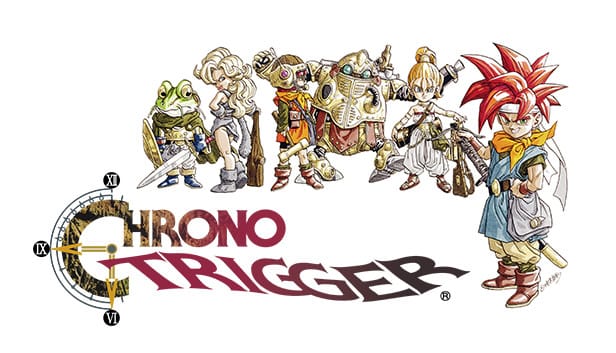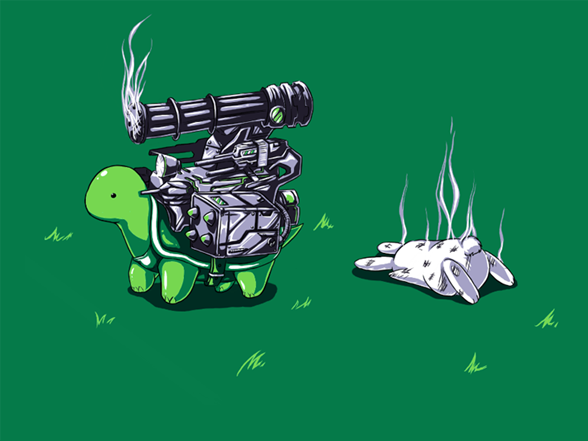February 15th, 2025. Final Fantasy 6.
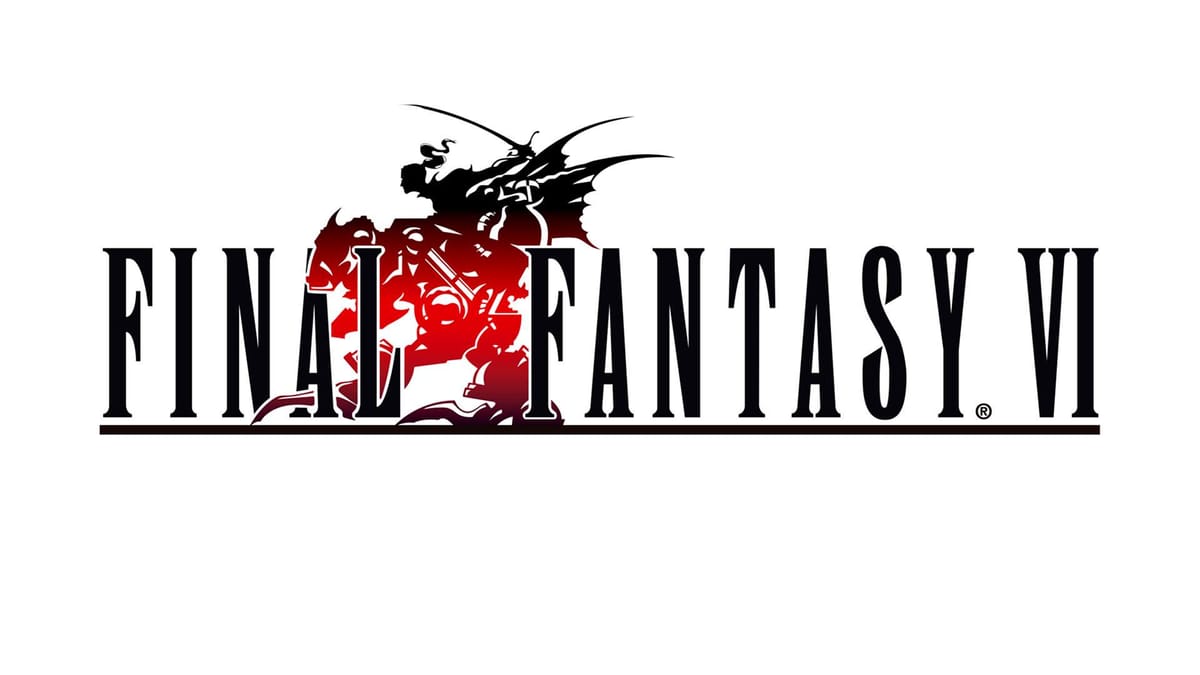
Whoa.
Just finished up Final Fantasy 6 via the Pixel Remasters just now. Practically 100%'d it. I really enjoyed it*!
The asterisk is for how imperfect the game is. I should preface this with my Final Fantasy cred. I have played Final Fantasy 1, 7, 10, 12, and 14. I also have beaten 7 Remake and Chrono Trigger. My favorite is probably either 7 Remake or 10.
FF6 was released in 1994, with only around a year of development time. It was initially released on the SNES, meaning it had to fit into an SNES cartridge, which is probably its biggest limiting factor.
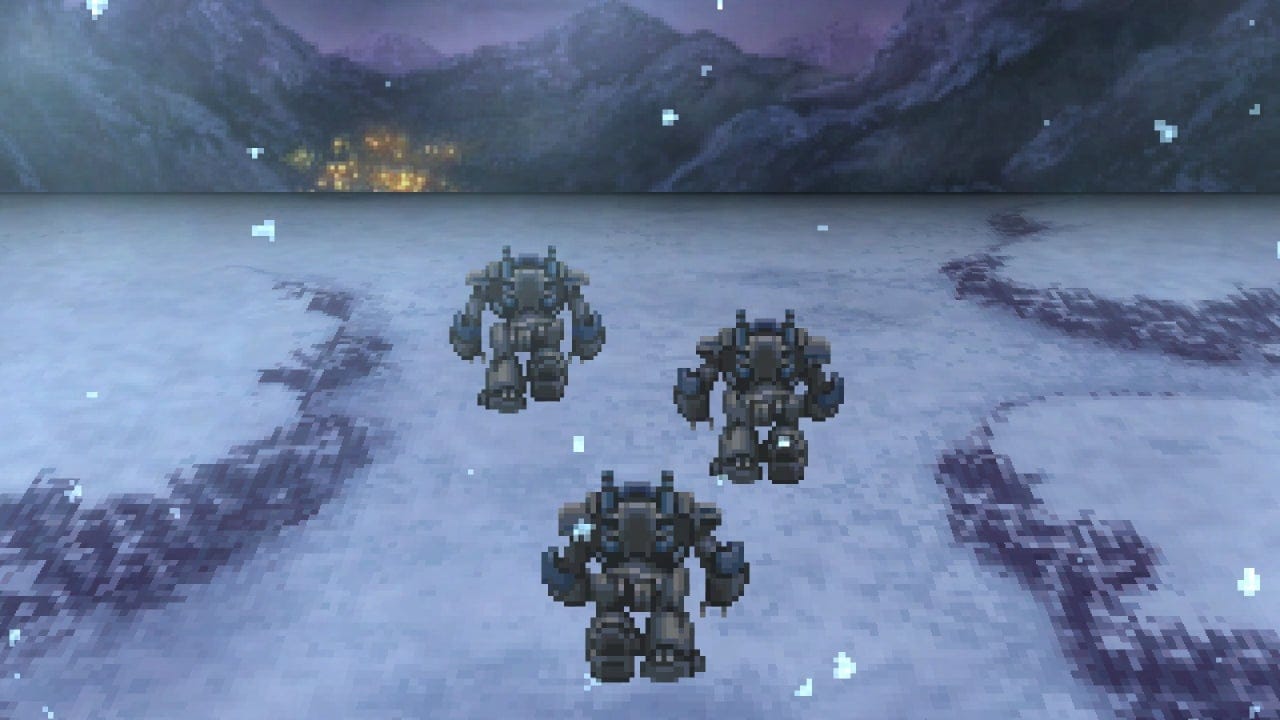
The game basically maxes out its cartridge, which kind of stings because of how grandiose the game is aiming to be. After all, it's a game with 11 main characters and 3 optional ones. It's got two world maps, roughly a hundred boss fights, and a final boss with four phases.
The game's story is the weirdest part to me. It moves really quick, in general, probably too fast, with a lot of sections just not getting enough time. Iconic sections, like the Opera House and the Phantom Train, are only half an hour, with about a dozen lines of dialogue for each one. That's really the part that stings the most, the lack of dialogue. With so many characters, the main ones just do not get enough dialogue to flesh them out. And in many scenes, they don't know who is in the party, so they have the characters say generic dialogue. This results in a lot of dialogue that just doesn't have much character or personality.
Combat wise, it's a mixed bag, wildly uneven in difficulty. The early game, for example, has Edgar curbstomping everything, using powerful tools like Autocrossbow, Drill, and Chainsaw. When I realized that they had infinite uses, I just spammed away to conserve MP. The same goes for Sabin, with his powerful martial arts moves. Cyan is similar, though his moves fall off in terms of damage towards the end of the game.
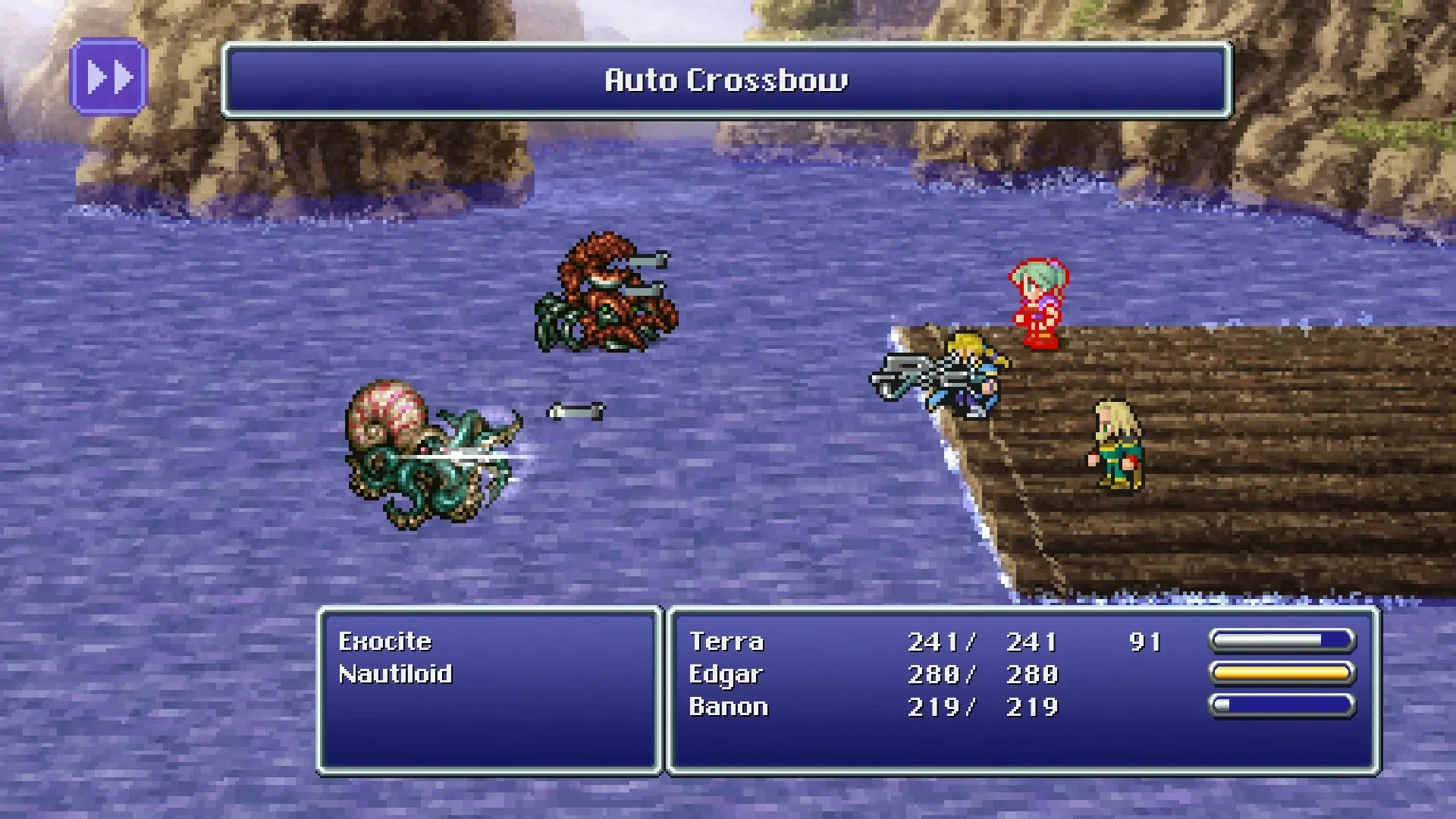
In contrast, characters like Setzer, Mog, and Strago have abilities that either aren't useful, or are too unreliable. Relm's draw is similar, though thankfully her incredibly strong Magic stat allows her to be a powerhouse.
Magic is overpowered. This is widely known, and yet I was surprised by just how much it lets you brute force the game. You can easily replenish MP by using Tent's at save points, or just resting at inns for cheap. And the Magicite system, while confusing at the start, becomes pretty intuitive. And by intuitive, I mean busted. Magicite lets you teach every character every move, so I had many characters with over three dozen moves. And most of them were useless, because I only had to click the most powerful spell they had to win battles.
Towards the end of the game, I had a party with Terra, Celes, Sabin, and Relm just tearing through everything. With Terra, Celes, and Relm all using Ultima to nuke everything, with Gold Hairpins to halve the cost of the spell.
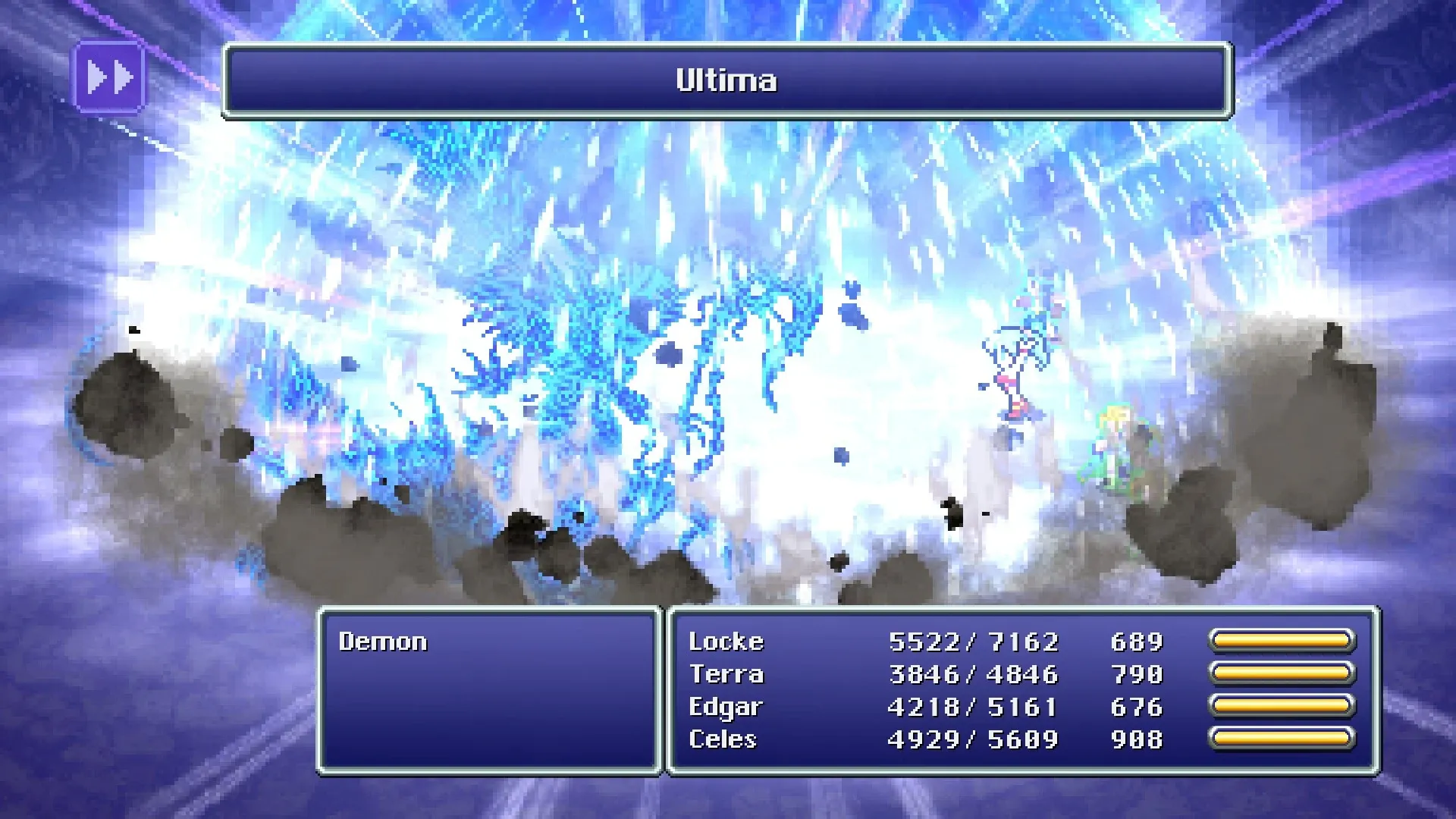
But before I talk about the end of the game, let's talk about the beginning of the game, and the story in general. I'll just list out the plot so you can see just how buckwild it is.
1000 years ago, the War of the Magi was fought, where people and espers used magic and almost tore apart the world. Since then, both magic and the espers have almost entirely vanished. But the Gestahl Empire, with advancements in its research into magic, have both industrialized and militarized, and launched an all out war across the world for global domination.
In the game, you play as Terra, a brainwashed soldier of the Gestahl Empire, who is able to use magic, which is almost extinct by now. She is freed of her brainwashing, and teams up with the Returners, a secret group of rebels, to fight the empire and learn more about her past.
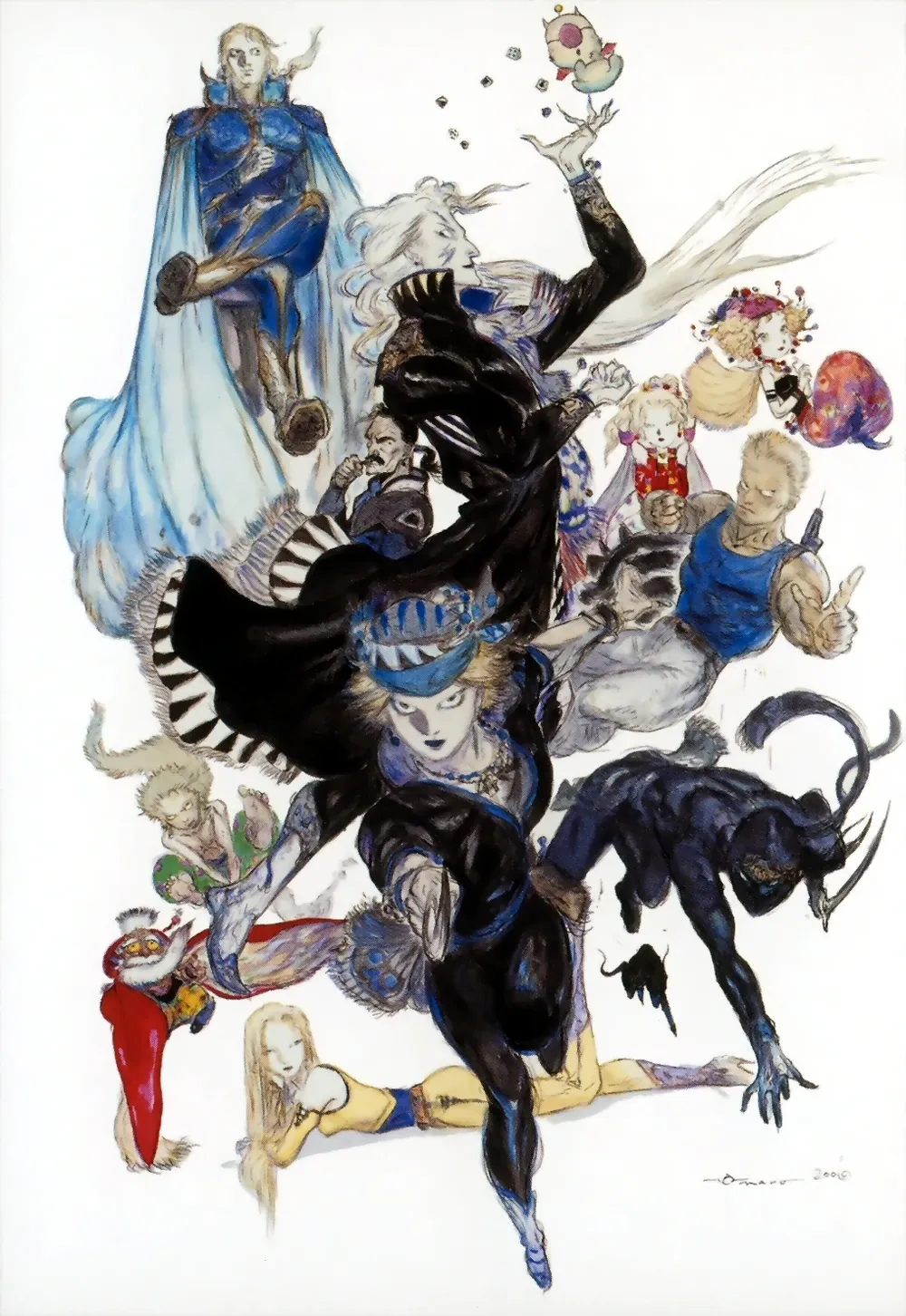
- Locke. A treasure hunter who protects women because of his failure to do so in the past.
- Edgar. A machinist, and King of Figaro, and a lady's man. He is charming but noble.
- Sabin. A monk, and brother of Edgar, who left Figaro to train. Strong, lighthearted, but equally noble as his brother.
- Shadow. A mercenary ninja who comes and goes along with his dog, Interceptor. He rarely speaks, but his backstory is revealed if you rest at inns.
- Cyan. A samurai of the nation of Doma, which gets destroyed by the Empire. He is old-fashioned, and grapples with the loss of his loved ones.
- Gau. A child who was abandoned by his father in the Veldt, a wild savannah. Since then, he has become a strong beast-child.
- Celes. A general of the Empire who was engineered to be able to use magic. She defects, and is rescued from captivity by Locke.
- Setzer. A gambler who flies the only airship in the world, the Blackjack. He enjoys his freedom above all else, while secretly mourning his partner.
- Strago. A Blue Mage from the town of Thamasa, the last town of human magic users in the world. He is an old man looking over his granddaughter, Relm, but was a monster-hunter when he was younger.
- Relm. A young Pictomancer, who can paint monsters to fight for her. She is energetic and spunky, and provides motivation for her grandfater.
Notably, the game does not really have a main character. Terra and Celes are the closest to being the protagonist, but even then there are many sections where you don't play as either of them. The same goes for Locke, Edgar, Sabin, and Cyan.
You meet all these characters throughout the first half of the game, in the World of Balance. Despite the Gestahlian Empire and its war, the world is a lot better than it is in the second half...
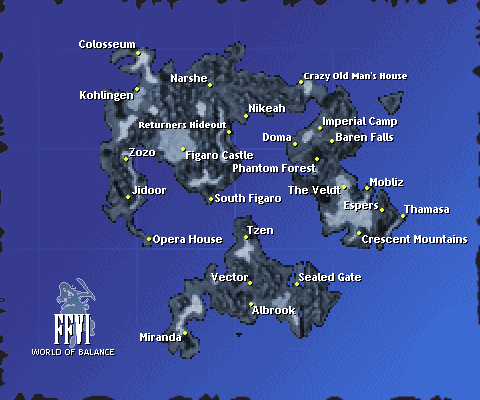
The first half juggles a lot, between introducing the main characters, the Empire, the Espers, and ping-ponging you across the world and its continents. The game is incredibly linear in the first half of the game, agonizingly so in my opinion. The game simply does not press the brakes to let you explore, or do an optional dungeon. Even when you control the Blackjack, the airship, which should give you a huge sense of freedom, there are no locations to go to that you haven't been to before. And not much has changed when you go back. It makes this world feel very artificial.
This flips at the end of the first half of the game. In the floating continent, which used to be the Esper world... the characters pursue the power-hungry Emperor Gestahl and his general, the mad jester Kefka. They seek the power of the Warring Triad so they can become gods and rule the world. The Warring Triad are the gods of this world, who created all magic and fought each other for supremacy. They realized their battle would destroy the world, so they chose to freeze themselves into stone statues in a triangle, so that no one could over power another. The party confront the Emperor, but Gestahl uses the magic of the Warring Triad to overpower them. Kefka, who has always been the number two to Gestahl up to this point, strikes, and takes the power of the Warring Triad for himself. He moves the Warring Triad out of alignment, and causes the world to fall into absolute chaos.
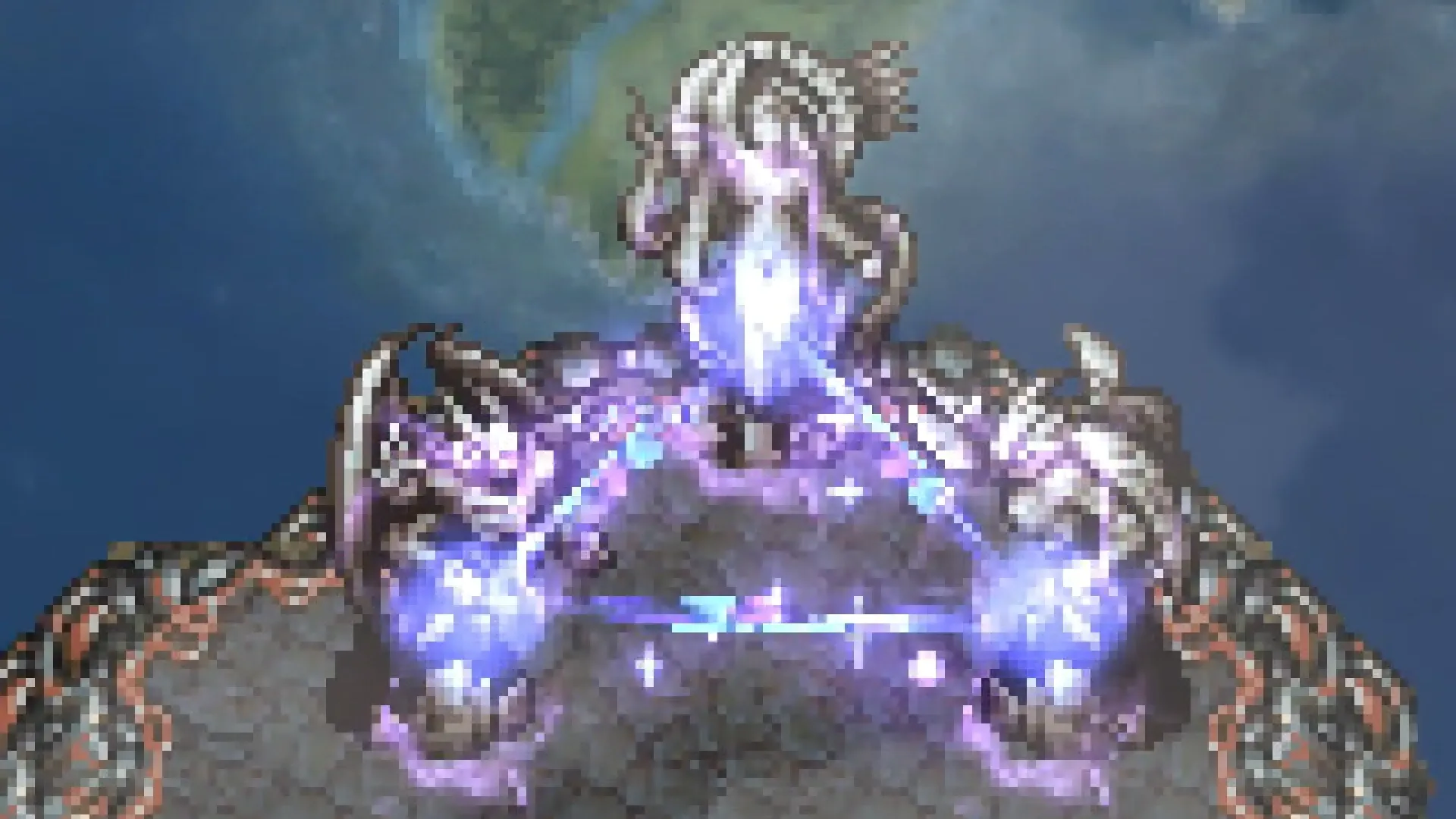
The party is scattered across the world in the aftermath, and one year later, Celes awakens. You play as Celes for the next bit. She was saved by Cid, chief engineer for the Empire who decided the war was wrong. They're stranded on a deserted island. Everyone else on the island fell into despair and threw themselves off of the northern cliff. For all they know, they could be the last two people alive on the planet. They decide to live their lives out together, with Cid acting as Celes' grandfather. But Cid passes away(probably, it depends on the player's actions), and Celes, in her own despair, jumps off the cliff like the others.

But Celes doesn't die, and washes up ashore of the island. She finds a bird with a bandanna around its neck, like Locke's. Maybe he's alive? She walks into Cid's shack, and finds a message from him, telling her to go out and find her friends, and to live on. Following the letter's instructions, Celes finds a secret raft that Cid had been working on, and she leaves the island to find her lost friends.
The rest of the game takes place in the World of Ruin, probably my favorite part of the game. While the combat gameplay is really suffering by now, because many characters have powerful magic they can just spam, there is a great deal of freedom.
And it's similar to games like many of the earlier Zelda games, like Majora's Mask, Ocarina of Time, and Link to the Past. A world after the apocalypse, but still clinging on. The Returners and Empire are gone, their war doesn't matter anymore. All that's left are people trying to survive, and new stronger monsters that roam the wasteland. One by one, you gather your friends, so that you can defeat Kefka and restore hope to the world. They're in various positions. Sabin and Edgar are still pretty active. You find Sabin in a town, holding up a crumbling house so Celes can rescue a child. Edgar is working with some thieves to break into Figaro Castle, so he can restart the castle and save everyone trapped inside.
But everyone else is stuck alone somewhere. Terra is in a destroyed village, helping protect a group of orphaned children as their "Mama". You can meet her early, but she refuses to join, as she feels she has lost the will to fight, now just wanting to stay and protect the children. Setzer is at a bar, drinking away, where a pep talk motivates him to keep fighting. He hid his partner's airship, the Falcon, underground in her tomb after she passed away. Having lost the Blackjack in the apocalypse, now the Falcon is truly the only airship in the world. And with the Falcon, you really get a chance to explore, and revisit all the old towns. Some, like Jidoor and Zozo, really haven't changed, but many are in ruins with people in despair(gameplaywise, they're mostly the same). There are also lots of additional, optional dungeons. The Phoenix Cave, the Cultist's Tower, the Ancient Castle, Ebot's Rock, Mt. Zozo, Narshe, the Zone Eater's belly, Owzer's Manor, the Cave in the Veldt.
Technically, you could assault Kefka's tower after obtaining the airship, meaning Celes, Edgar, and Setzer are the only mandatory characters, with Sabin very likely to have joined by this point. But you really do feel encouraged to explore, to find your friends and see what they've been up to in the apocalypse.
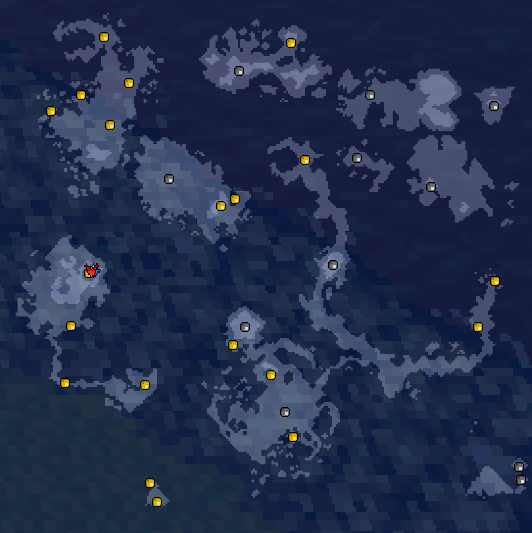
Cyan is in a cave, on Mount Zozo. He's been writing letters to a soldier's girlfriend, impersonating the soldier so she doesn't have to know that the soldier died due to Kefka's wrath. But he finds his resolve, and decides to tell her the truth, so that both he and her can move on from the deaths of their loved ones, and look towards the future. Gau is on the Veldt again, seeking to get stronger so he can defeat Kefka. Relm is in Owzer's Manor, having been hired as a personal painter for the rich man. Strago has given to despair, assuming that Relm has died, and has mindlessly joined the Cult of Kefka, marching endlessly to try to appease Kefka. Shadow is in the Cave in the Veldt, trying to find the sword Ichigeki, but wounded by the powerful beasts in the cave. Locke is in the Phoenix Cave, which houses the Phoenix Magicite which can bring the dead back to life. He lost the love of his life, Rachel, in a cave, but has preserved her body. He wants to bring her back to life, because of his failure to protect her then. But the Magicite fails, and only revives her for a few seconds, where Rachel thanks Locke for everything he has done, and tells him that she will always love him. Before passing away again, she encourages him to move on, and find new love.
And Terra, still in the ruined village, finds the resolve to fight, for the sake of bringing peace to the world, so that her children can live lives without fear.
I personally love the World of Ruin. What impresses me the most is that they planned for the game to end at the Floating Continent, with the party defeating Gestahl and Kefka and preventing the end of the world. But allowing Kefka to win was incredibly powerful, giving the world so much more character and melancholy. Now he sits on a massive tower, built from the ruins of the Gestahl Empire's capital, now as a god, searing whatever he sees fit with rays of light. I just wish Kefka got to interact more with the party at this point, commenting on their actions and speaking more of his own beliefs at this point.
With so many dungeons, you'll look around for loot, which highlights one of the strengths of the game. The loot system is kind of awesome. You have a primary weapon and an offhand slot, usually for a shield. You have a helmet, a chestpiece, and two relic slots, which act like accessories. But in the World of Ruin, the gear is truly insane. When you imagine a Thunder Shield, you probably think of a shield that just absorbs lightning. But no, in FF6, it also nullifies Wind damage, and halves the damage taken from Fire and Ice. You have armor pieces like the Minerva Bustier, which gives +25% max MP, +1 Strength and Stamina, +2 Speed, +4 Magic, and nullifies Fire, Ice, Lightning, and Wind, while taking half damage from Earth, Water, Poison, and Holy damage.
The accessories are the best part. The Ribbon, a classic, nullifies all negative status ailments. The Crystal Orb raises max MP by 50%. The Growth Egg doubles EXP gains. The Miracle Shoes give you free Protect, Shell, Regen, and Haste buffs. The Golden Hairpin halves the MP cost of all spells. The Soul of Thamasa lets you doublecast spells. The Black Belt lets you do automatic counterattacks. The Sniper's Eye makes it so physical attacks will never miss. The Genji Glove lets you equip two weapons, and attack with both at the same time. The Earrings boost magic damage by 25%. The Hero Ring boosts all damage by 25%. The Ward Bangle halves encounter rate. The fact that you can only equip two of these at a time makes it so you kind of have to agonize about what you want and have to give up.

And these items will let you tear through the final dungeon, Kefka's tower. A labyrinth requiring you to control 3 teams of characters, you defeat mythical dragons, the strongest Magitek that the Gestahlian Empire used to wield, the Warring Triad itself, and of course, Kefka. Kefka is outrage by the party still having hope, and vows to destroy everything and everyone so no one can ever have hope again. Kefka himself is not very deep, but I do enjoy a character so thoroughly and unashamedly evil.
Despite all his evil, he dies pretty fast. He has 62000 HP, and Ultima was, by this point, doing 9999 damage, the damage cap. With Terra casting it, and Relm doublecasting it, he died in 7 casts of the spells. My party was around level 40 by the time they defeated him, though I neglected many of the other characters. That's another one of the issues in the game. You have so many characters that you really don't want to level them all up, and teach them all powerful magic. Gau, Strago, and the optional characters, Mog, Umaro, and Gogo, were all pitifully weak especially at the end, with even Locke, Edgar, Shadow, and Cyan struggling to keep up and be impactful.

But before I finish this off, I should highlight some other strengths of the game. First of all, the music. The music is absolutely incredible. Dancing Mad, Searching For Friends, Shadow's theme, Forever Rachel, Dark World, and the Opening Theme are all so memorable, really standing out, but the bar of the music is consistently high throughout the whole game. It does get a bit repetitious though, with many themes being short and looped.
The visuals were really good, but there are some caveats. First, there is a lot of reuse of assets. As a result, towns will lack unique landmarks to give them character, and there are a LOT of caves. In fact, most of the dungeons in the game are caves, making it somewhat boring to look at. The enemy sprites were incredibly detailed, but also each got recolored at least 2 or 3 times, making endgame fights uninteresting because you were fighting beefed up enemies you've already seen before. The character sprites in the Pixel remaster just aren't as good. Others have pointed out how much brighter they are now, making them stick out, but I also am disappointed by the lack of depth. Their sprites now seem flat, when the shading in the SNES version gave them much more solid faces. Plus, their old sprites just fit the aesthetic of the game as a whole much better. I really wish there was an option to use them in the Pixel Remaster.
Lastly, I did really love some story sections of the game. Terra's story of finding a reason to fight, out of love, not for a lover but for her adopted children, was both unique and emotional. Locke's relationship with Rachel is... kind of weird(he kept her body in stasis for years???), but also really interesting, and Rachel's last speech to Locke was very good, though it does feel like there's a lack of chemistry between Celes and Locke, they just don't get a lot of lines together. Celes makes an excellent protagonist at the start of the World of Ruin, the story of her and Cid, all alone at the edge of the world, is really moving. It makes her journey across the ruins of the world to gather her friends so much more powerful. Shadow also has a secret backstory revealing that he was once a mercenary who traveled to Thamasa, and fell in love, resulting in the birth of Relm. But Shadow was a wanted man, so he left Relm behind, becoming a masked mercenary living a life of violence. I wish Shadow and Relm got some scenes together towards the end, it would've been really nice.
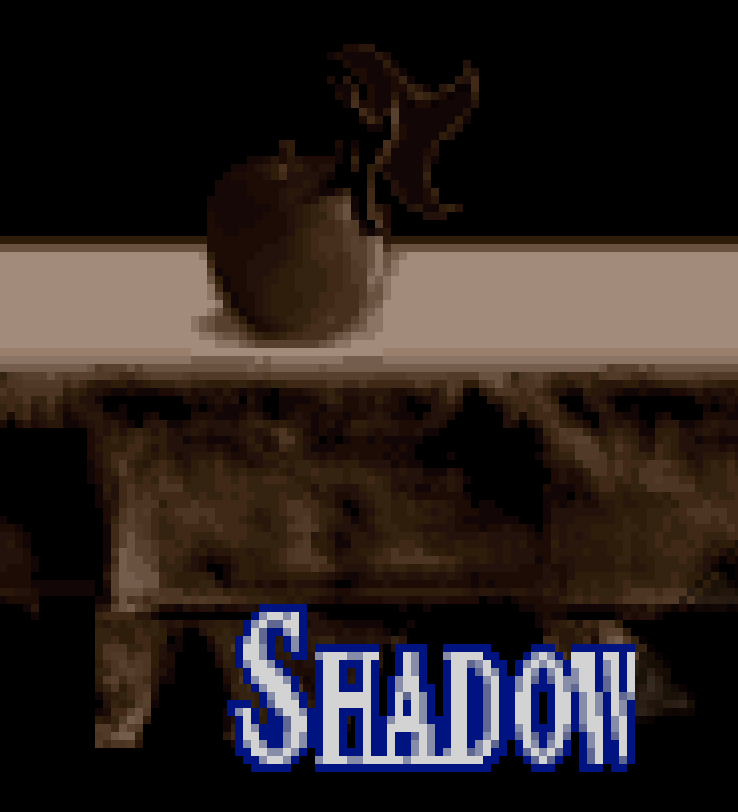
That does not mean necessarily everything in the story worked for me. The Gestahlian Empire and the Returners just kept reminding me of Star Wars, and neither faction really got fleshed out that much. Cyan's story of losing his wife and son because of Kefka's cruelty is nice, but I wish it wasn't the only note of his arc. It comes up in his introduction, in the Phantom Train, and again in his Dreamscape. His small story of writing the letters to the soldier's girlfriend was actually really touching. In this ruined world, he doesn't have the heart to let her know that her loved one is dead. Edgar and Sabin are fun, but they really don't have a character arcs. It does make it fun however to see in the World of Ruin that they are the characters who haven't lost hope, and have continued to fight.
I think the unifying thing here is that I wish the game was more. The game is already pretty big, at about 30 hours for me to beat, but I wish there was more of everything. More dialogue, more cutscenes for each character, more exploration and optional content in the World of Balance, longer dungeons, more visual variance in those dungeons, more lore. But I also realize this game can barely handle itself. The SNES cartridge is actually packed to the brim with data, which is why there is so much reuse of sprites and textures.
But the game, as it is? It's still pretty damn good. And I did tear up at the ending, seeing the characters, now legendary heroes, helping each other escape the crumbling tower. They have stylish credits, like the game was a dramatic play, with a scene highlighting each of them. It's really damn impressive that they crammed this whole game into around 2 megabytes, all in one year. While the end product isn't perfect, I think being able to make it in the first place should be treated as an achievement. And many of these lessons would be taken in all the right ways for Chrono Trigger, which is kind of a brother to FF6. Bravo, Square of 1994.
